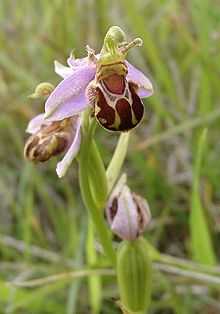Ophrys apifera
| Ophrys apifera | |
|---|---|
 | |
| Ophrys apifera var. aurita | |
| Scientific classification | |
| Kingdom: | Plantae |
| (unranked): | Angiosperms |
| (unranked): | Monocots |
| Order: | Asparagales |
| Family: | Orchidaceae |
| Genus: | Ophrys |
| Species: | O. apifera |
| Binomial name | |
| Ophrys apifera Huds. | |
| Synonyms | |
Ophrys apifera, known in Europe as the bee orchid, is a perennial herbaceous plant belonging to the family Orchidaceae.
Etymology
The name "Ophrys" derives from the Greek word ophrys, meaning "eyebrow", while the Latin specific epithet apifera means "bee-bearing" and refers to the bee-shaped lip of the orchid.
Description
Ophrys apifera grows to a height of 15–50 centimetres (6–20 in). This hardy orchid develops small rosettes of leaves in autumn. They continue to grow slowly during winter. Basal leaves are ovate or oblong-lanceolate, upper leaves and bracts are ovate-lanceolate and sheathing. The plant blooms from mid-April to July producing a spike composed from one to twelve flowers. The flowers have large sepals, with a central green rib and their colour varies from white to pink, while petals are short, pubescent, yellow to greenish. The labellum is trilobed, with two pronounced humps on the hairy lateral lobes, the median lobe is hairy and similar to the abdomen of a bee. It is quite variable in the pattern of coloration, but usually brownish-red with yellow markings. The gynostegium is at right angles, with an elongated apex.
Reproduction
It is the only species of the genus Ophrys which preferentially practices self-pollination. The flowers are almost exclusively self-pollinating in the northern ranges of the plant's distribution, but pollination by the solitary bee Eucera occurs in the Mediterranean area. In this case the plant attracts these insects by producing a scent that mimics the scent of the female bee. In addition, the lip acts as a decoy as the male bee confuses it with a female. Pollen transfer occurs during the ensuing pseudocopulation.[citation needed]
The flowers emit allomones that attract the bee species Tetralonia cressa and Eucera pulveraceae. Eucera longicornis males have been observed attempting to copulate with the flowers.[1] It is believed that male bees would preferentially select orchids with the most bee-like lips and attempt to mate with them, transferring pollen in the process.[2]
Distribution
Ophrys apifera is a temperate climate species, widespread from the Atlantic to the Caucasus. It is quite common in the Mediterranean region eastwards to the Black Sea,[3] (Codes) [4] but is less common in its northern range being uncommon or local in Germany and Ireland.
In the UK, it has a distinct southeastern preference, being more common in England. Recently it's been found in the southwest in Butleigh near Glastonbury in Somerset; whereas it is only to be found in coastal regions of Wales as well as the Hodbarrow Nature Reserve in Millom, Cumbria,[5] and some parts of Northern Ireland. It is relatively common in the northeast of England and in recent years large numbers have appeared in the grass verges surrounding the Metro Centre in Gateshead.[6] In Scotland, it was thought to be extinct, but was rediscovered in Ayrshire in 2003. In some countries the plants have protected status. They are unusual in that in some years they appear in great numbers, then sometimes only reappear after an absence of many years.
Habitat
Ophrys apifera generally grows on semi-dry turf, in grassland, on limestone, calcareous dunes or in open areas in woodland. It prefers calcareous soils, in bright light or dim light.
Culture
Ophrys apifera is the County flower of Bedfordshire.[7]
Varieties
- Ophrys apifera var. apifera
- Ophrys apifera var. bicolor
- Ophrys apifera var. botteronii
- Ophrys apifera var. friburgensis
- Ophrys apifera var. immaculata
- Ophrys apifera var. trollii
Varieties of Ophrys apifera




References
- ↑ Fenster, Charles B.; Marten-Rodrıguez, Silvana (2207). "Reproductive Assurance and the Evolution of Pollination Specialization". International Journal of Plant Sciences (The University of Chicago) 168 (2): 215–228. doi:10.1086/509647. Retrieved 2 September 2013.
- ↑ Dawkins, R. (1986) The Blind Watchmaker
- ↑ "World Checklist of Selected Plant Families".
- ↑ "World Checklist of Selected Plant Families TDWG Geocodes".
- ↑ http://www.rspb.org.uk/reserves/guide/h/hodbarrow/index.aspx
- ↑ http://www.journallive.co.uk/north-east-news/todays-news/2008/06/21/orchid-colony-discovered-in-grass-verge-61634-21129155/
- ↑ Plantlife website County Flowers page
External links
-
 Media related to Ophrys apifera at Wikimedia Commons
Media related to Ophrys apifera at Wikimedia Commons -
 Data related to Ophrys apifera at Wikispecies
Data related to Ophrys apifera at Wikispecies - Ophrys apifera at the Encyclopedia of Life
- Biolib
- Ophrys apifera
